
Dear departed: Flanked by the mothers of the other two martyred men, Carolyn Goodman ’36 (center) leaves the Society for Ethical Culture after her son’s memorial service. Photographs from CorbisImages.com unless otherwise noted.
Since childhood, I had always been in love with the stage, and I spent a few years acting in a community theater. One play in particular remained vivid in my memory. It was an antiwar drama called Bury the Dead in which, as a teenager, I played the mother of a dead soldier. At one point, in a surreal setting, I stood on stage in a state of denial that my son had been injured while a group of soldiers crouched below me in a trench. One of them was the actor playing my son.
“Let me see your face, son,” was my line. And I repeated it over and over. “Let me see your face, son.” Finally, he turned to me, showing me the little that was left of his face. He was dead. All the men in the trench were dead. My response was to scream. I did, and a primordial sound came out, remarkably heartfelt and drenched in emotion. I screamed that scream over and over every weekend.
Some three decades later, on June 21, 1964, my son disappeared. It was Father’s Day and only Andy’s second day in Mississippi. The longest day of the year became the longest day of my life.
Having driven all night from Ohio before going to examine what was left of the Mount Zion Methodist Church, Andy, Mickey, and James had not returned. We received a phone call that night from members of the Student Nonviolent Coordinating Committee, who explained their hard and fast rule that everyone was supposed to be back before dark. Here it was, late at night, and nobody had heard from them. Nobody knew where they were.
The very first day of Freedom Summer, and three volunteers were already missing in Mississippi. The fact that my son was one of them shook me to my soul. But I didn’t allow the dark possibilities in the back of my mind to creep into my thinking. Not yet, at least. As my husband, Bobby, once wrote to me: “It’s still as Freud put it—to know a thing and to accept firmly in your own mind the truth of what you know are such opposite poles of realization that this simple process has become one of the most difficult elements in human endeavor and the root of all personal failure.”
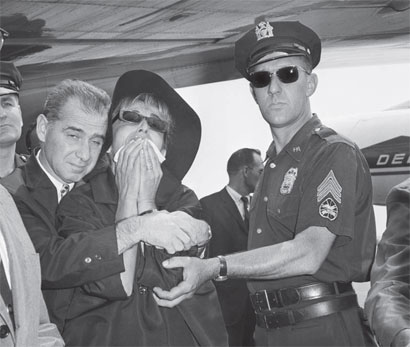
Burden to bear: Supported by her husband, Robert Goodman ’35, BS Eng ’39, Carolyn Goodman weeps as her son’s body arrives at Newark Airport.
The following day, a phone call to the Neshoba County jail revealed that Andy, Mickey, and James had been arrested the previous afternoon for speeding in their blue Ford station wagon. They hadn’t been seen since. The FBI, having already begun a church arson investigation, became intensely involved, eventually devoting 153 men to the case. When officials began searching in the swamps and forests of Mississippi, they didn’t find the bodies of my son and his colleagues. But they did find a number of other bodies—local African Americans who had gone missing over the years. It was that kind of place and that kind of time, suffering from that kind of inequality between the resources and attention given blacks and whites.
Within two days, the case had begun to galvanize the country, so much so that Bobby and I, along with Mickey’s father, Nathan Schwerner, flew to Washington, D.C., where President Lyndon Johnson personally greeted us and told us he would do everything in his power to find our sons. When we returned home, not long after we walked into the house, President Johnson called to tell us that an abandoned, badly burned, blue Ford station wagon had been found in a swamp thirteen miles northeast of Philadelphia, Mississippi.
I screamed in agony. This time it was real.
That same day, we received a postcard Andy had mailed upon arriving in Mississippi. He had been told to write us a positive message. That way, no matter who read it, they would get no revealing information. For decades, the card remained on my mantelpiece.
For the next six weeks, dozens of reporters would crowd into our living room or gather in front of the building on Eighty-Sixth Street, day after day, as I gave interview after interview, pleading to the people of Philadelphia, of Mississippi, of anywhere really, for help in tracking down my son. As the days passed, I still managed to generate a flicker of hope that perhaps Andy and Mickey and James were simply being kept somewhere, held out of sight. Most of the young people with whom we were in contact knew they were dead, but I didn’t allow myself to think that way. I couldn’t.
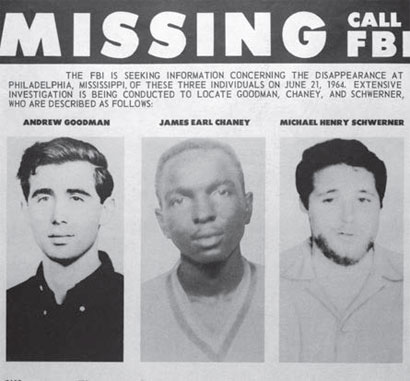
Lost sons: The FBI’s now-iconic poster.
Bobby and I managed to endure somehow, in part because we rarely had time to ourselves—time when we could truly reflect on the horror of the situation. Our house was full of people—not only the media, but also friends and family providing constant support. And FBI agents, who were providing constant surveillance. They would sit in a back room, tapping our phones with primitive recording equipment. And, in fact, we received a number of detestable phone calls from people demanding ransom in return for my son. No lead led anywhere.
Forty-four days after they went missing, Bobby and I tried to ease our pain with music in the form of a concert at Lincoln Center. There, in the middle of a performance, a friend came rushing down the aisle and pulled us from the auditorium. They had found the bodies. On August 4, the FBI, acting on an informant’s tip, bulldozed an earthen dam on the outskirts of Philadelphia and uncovered the very scene I had been dreading most.
‘Our grief, though personal, belongs to our nation,’ Robert Goodman declared. ‘This tragedy is not private. It is part of the public conscience of our country.’ The following day was Bobby’s fiftieth birthday. Somehow he managed to get through a public statement that encapsulated our grief, our expectations, and our continued values:
The passage of many weeks of uncertainty has ended in the knowledge of the murder of our son Andrew Goodman and his companions, James Chaney and Michael Schwerner. Hope, slim though it was, has passed away and a painful certainty has come. Our grief, though personal, belongs to our nation. This tragedy is not private. It is part of the public conscience of our country.
It is necessary, especially in such a time of agony, to confront ourselves with our own history and the social sickness that still remains long after “the binding together of our nation’s wounds” that was our Civil War. The values our son expressed in his simple action of going to Mississippi are still the bonds that bind this nation together—its Constitution, its law, its Bill of Rights. Whenever and wherever part of a people mock our heritage, as has now and again been done, we must respond with the full power and strength of our heritage. The solution of this crime and punishment of those who have committed it is necessary as part of the process that will enable this nation to endure.
Throughout our history, countless Americans have died in the continuing struggle for equality. We shall continue to work for this goal, and we fervently hope that Americans so engaged will be aided and protected in this noble mission. For ourselves, we wish to express our pride in our son’s commitment and that of his companions now dead; and that of his companions now alive, now in Mississippi, acting each hour to express those truths that are self-evident.
In Washington four weeks ago, my wife and I in a sense made a pilgrimage to the Lincoln Memorial in the evening, and stood in that great shrine looking down past the Washington Monument toward the soft glow of the light around the White House. Full of the awe of a great nation that surrounded us, we turned to read, emblazoned in black letters on the white marble, “It is for us the living to dedicate ourselves that these dead shall not have died in vain.”
The story that emerged of how they died—painstakingly pieced together by Seth Cagin and Philip Dray in the book We Are Not Afraid—was awful, not only in its violence and the devastation of so many lives, but also in the series of what-ifs. After the trio had driven away from the church that day, they had a choice when they reached Highway 16: a twenty-five-mile route straight to Meridian, or a longer one through Philadelphia. They chose the latter, perhaps believing it to be safer. If they had chosen otherwise, they might all still be alive today.
As they drove toward Philadelphia, Neshoba County deputy sheriff Cecil Ray Price passed them going the other way. He made a U-turn, having recognized the station wagon, and caught up with them just inside the city limits. Price was a Klansman, not a rarity in Mississippi law enforcement in those days, and he was eager to impress his friends by stopping Mickey Schwerner and his colleagues. He arrested James for speeding, and he apparently told Andy and Mickey that they would be held as suspects in the church arson.
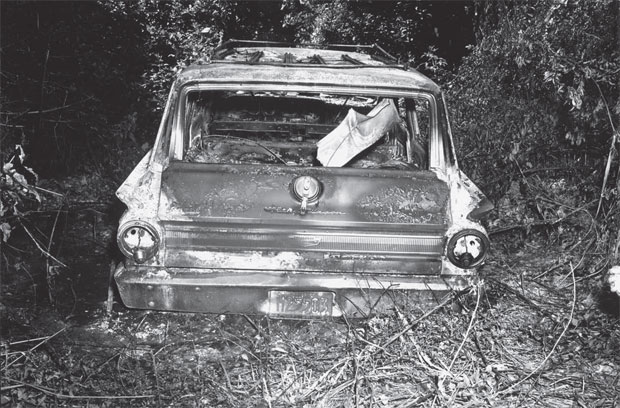
Crime scene: The trio’s burned station wagon was found in a swamp shortly after their disappearance. That day, Goodman’s parents received his postcard saying that Meridian, Mississippi, “is a wonderful town and the weather is fine.”
It was more than six hours later that the three were finally released from their jail cells. They hadn’t been allowed to make phone calls, but Mickey had previously instructed a colleague to call every jail and sheriff’s office along their planned route if they hadn’t arrived by four that afternoon. The Neshoba County Jail received a call at 5:30. No, came the lie, the men hadn’t been seen all day.
Caution had been a significant part of the training for the Mississippi volunteers. They were given tips: Don’t give a sniper a target by standing in an open window. Know the roads in and out of town. Beware of cars without license plates and policemen without badges. And don’t go anywhere at night. But when Andy, Mickey, and James were released (James having paid a $20 fine), they left anyway without making a phone call, a sure signal that something was wrong. James drove south on Highway 19 toward Meridian. Unbeknownst to my son and his friends, Price and Sheriff Lawrence Rainey were involved in a plan to ambush them.
Two carloads of Ku Klux Klan members took off after them. One car broke down; the other kept going, joined by Price in his police cruiser. Eventually, not far from the Lauderdale County line, Price caught up and turned on his lights. James made the fateful decision to pull over. Andy, Mickey, and James—to me, they weren’t the “three civil rights workers,” as they became forever known; they were Andy and Mickey and James—were placed in the backseat of Price’s cruiser. He and the other Klansmen, one of them driving the station wagon, turned around and headed back toward Philadelphia. But before reaching the city, they turned left at an unlit, unmarked dirt road and stopped. “So you wanted to come to Mississippi,” one of the Klansmen reportedly said. “Well, now we’re gonna let you stay here.”
Mickey was killed first, shot in the heart. Andy was second. James was last, and he may have been severely beaten, too. They were buried under ten tons of dirt in a dam being constructed to create a cattle pond. Forty-four days later—after the FBI became involved while suspecting law enforcement officials, after the story had made front-page headlines throughout the country, after Sheriff Rainey had continued his sickening swagger and his contention that it was all a hoax, and after an unidentified citizen was paid $30,000 in reward money to reveal where the bodies were buried—the bodies were finally unearthed. Andy’s left hand was clutching soil that could have come only from the dam site, meaning he may still have been alive when buried.
That is how my son died.
I gave one last press conference in the apartment, rather numbly thanking the people from all over the nation for the many supportive letters we had received. Then the lights turned off, and one by one, the reporters and cameramen and technicians shuffled up to me at the front of the living room and offered their condolences. Many years later, longtime WNBC correspondent Gabe Pressman remarked that in his more than sixty-year career he had never seen that before or after.
The Schwerners wanted to bury their son next to his friend, James, in Meridian. But the state would not permit it. Even death, it seems, was segregated in Mississippi. We wanted Andy to be buried in New York, next to his grandfather, Charles, who had died only the previous year. When the body was shipped north, we had a simple funeral. The mourners filled the funeral parlor, but it wasn’t like the memorial service we had later, where the crowds spilled out into the streets of Manhattan.
I walked in, and there was the casket. And something happened.
When the boys were young, we used to take them on long car trips, often up to Tupper Lake. Andy had loved play-acting from the time he was a little boy, long before he became involved with the theater. We would be in the car, and Andy would reach back, grab whatever clothes were strewn about the car, and try them on. I recall one time in particular when he dressed up in an oversized sweater, a colorful scarf, and the funniest little hat. He was probably four or five years old, and he looked so darling, so funny, so alive.
I had never had a hallucination before and haven’t since, but when I walked into the funeral parlor that day I swear I saw Andy sitting on top of that coffin, cross-legged, dressed up as I had remembered him so many years earlier. I don’t know why, at that moment in my grieving, I remembered Andy as a five-year-old. I know I wanted him to be alive and that I wanted him to be with me, not in that. . . box.
Whatever the mind does in such situations, when I saw the coffin of my son, my dead twenty-year-old son, I suddenly saw the loving smile of a little boy.
Andy and his companions became symbols of the intransigence of the South and the righteousness of the cause. Andy didn’t go to Mississippi expecting to die. He simply went there to try to make it possible for people to go into a booth and vote. A hero? No. He was a beautiful, strong, determined person—and a great loss to his mother and father. He never aspired to martyrdom. But a martyr is what he became. Some of the seminal moments of the civil rights movement happened the year following his death, in 1965, including the historic march from Selma to Montgomery in Alabama and passage of the Voting Rights Act. They were inspired in no small part by the fate of three young men.
‘Andy didn’t go to Mississippi expecting to die. He simply went there to try to make it possible for people to go into a booth and vote.’Two years after Andy’s death, Bobby and I were inspired to carry on our son’s goals and dreams. We started the Andrew Goodman Foundation, which supports projects that work to advance human rights, civil liberties, economic justice, and youth activism. The Foundation serves as a growing legacy to Andy Goodman, but he has been immortalized in many other ways. At Cornell, a stained glass window in Sage Chapel was designed and dedicated to honor Andy, Mickey, and James. At Queens College, the library is the site of the Chaney-Goodman-Schwerner Clock Tower. In front of the rebuilt Mount Zion Methodist Church in Mississippi stands a memorial to the three men “who gave their lives in the struggle to obtain human rights for all people.” A four-block stretch of Manhattan’s Upper West Side is named “Freedom Place” in their honor. Trevor Day School, at the location of the Walden School where all three of my sons attended, has named a building after Andy. Songs have been written about Andy, Mickey, and James by the likes of Pete Seeger and Simon and Garfunkel. There is even a 2,176-foot mountain overlooking Tupper Lake that has been christened Goodman Mountain.
But my favorite tribute to Andy came from a little girl. In the weeks following his death, I was so devastated that I could hardly get myself to read the hundreds upon hundreds of letters from well-wishers. But when I noticed that one letter had S.W.A.K. (Sealed With A Kiss) scrawled across the back of the envelope, I recognized it as the writing of a child. So I opened it.
“Dear Mr. and Mrs. Goodman,” it began. “My name is Robin Goodman. I am ten years old, and I have a cat. Would you mind very much if I called him Andy?”
It was that kind of encounter—unexpected compassion and youthful innocence—that would remind me so much of my middle son, sending tears streaming down my cheeks.
Apparently, Robin had first seen Andy’s picture in the New York Times, a black-and-white headshot that appeared endlessly (alongside those of Mickey and James) in newspapers across the nation. Robin noticed that she and Andy, though unrelated, shared a last name. Like Andy, she also had a father named Robert Goodman. And like Andy, her father had traveled south, from his home in New Jersey, to assist voter registration in Mississippi. More important (to a preteen girl), she thought Andy was just about the most handsome young man she had ever seen. She daydreamed about him constantly.
Robin went to camp that summer in Upstate New York, where she and her friends watched the tragic story unfold over the next six weeks. Before the summer ended, the camp’s cat delivered a litter of kittens, and a name-the-kitten contest was held. Robin noticed a tiny ball of black-and-white fur and instantly realized that it should be named Andy. His last name, she figured, should be Goodman, just like hers. And so it became.
When Robin returned to school, she took up a collection to purchase two-way radios for civil rights workers, telling her classmates that this might have saved Andy and his friends. We continued to correspond occasionally. We invited her to Thanksgiving dinner, though she was unable to join us. As time passed and Robin became a teenager, we slowly fell out of touch.
The connections continued, however. Like Andy the thespian—and like my oldest son, Jonathan the musician—Robin pursued her dreams of becoming an artist. Like my youngest son, David, she attended Antioch College in Ohio. And like me, she eventually found herself married with two sons. Years later, in 1995, when her paintings were to appear at a gallery in the East Village, she sat down to make a list of people to invite. Her thoughts turned to me, whom she viewed as a woman who had reached out to a little girl despite my devastation. Of course, I interpreted it in much the opposite manner.
My friend Alie Fox joined me at the crowded gallery, and I told her that we should just stay for a moment. And after all, Robin had now reached middle age. I had no idea what she looked like. We took a look at Robin’s wonderful art and prepared to leave. Then I heard a woman’s voice. “Carolyn Goodman!”
I turned to see a curly-haired brunette. “I’m Robin Goodman.”
And for the first time, we embraced—two women, neither of whom had been graced with a daughter, weeping in each other’s arms, bonding over the memory of my son. Robin Goodman went on to become Robin Dash, an acclaimed artist and a member of the faculty at both Brandeis University and the New England Conservatory. The cat, she later told me, lived for fifteen years with her family. They loved Andy Goodman, too.
From MY MANTELPIECE: A MEMOIR OF SURVIVAL AND SOCIAL JUSTICE by Carolyn Goodman with Brad Herzog. Copyright © 2014 by the Andrew Goodman Foundation. Reprinted by permission. All rights reserved.
The Philadelphia Story
A cross-country trip inspires a writer’s two-decade-long journey
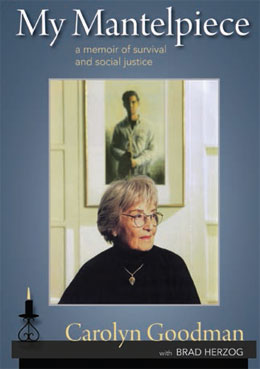
Book cover.
I first discovered the story of Carolyn Goodman ’36 during a cross-country road trip in 1996 while researching a book I was writing about places with names like Wisdom (Montana), Pride (Alabama), and Honor (Michigan). All I knew about most of these towns was that they were some of the tiniest dots on the map. I was aware, however, that the hiccup of Hope, Mississippi, was located next to a city called Philadelphia.
I knew about Philadelphia. It’s where three civil rights workers disappeared in June 1964 after visiting the ruins of a black church that had been firebombed by the Ku Klux Klan. They were part of the Mississippi Summer Project, an effort to flood the state with northern college students, teach disenfranchised African Americans about their constitutional rights, and conduct a massive voter registration drive. The oldest of the three was twenty-four-year-old Mickey Schwerner ’61, who was relentless in the cause and thus despised by the local Klan. His brave colleague was a twenty-one-year-old black Mississippian, James Chaney. The third volunteer had just arrived in the state. He was Andy Goodman, Carolyn’s son.
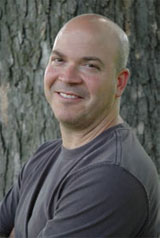
Brad Herzog ’90. Photo provided.
As I drove around Philadelphia, I had the eerie experience of revisiting the events of that fateful day while exploring the actual setting—the Neshoba County jail, the rural highway, the unmarked dirt road where their lives ended violently. I sat down with an African American woman who haltingly informed me that her landlord was the man on whose property the bodies were buried for forty-four days. Like most of the men involved, he was later acquitted of the crime. But I found myself most captivated by the notion of a mother’s internal battle—role model vs. protector—when considering whether or not to permit her son to volunteer in Mississippi. “My son wanted to be a beacon of light in the heart of darkness,” Carolyn later told me. “How could I deny him?”
While writing a feature story for Cornell Alumni Magazine—and then later, through countless interviews after she asked me to co-author her memoir—I came to marvel at Carolyn’s story. Hers was a life punctuated by tragedy: a brother’s premature death, childhood molestation, a father’s suicide, a son’s infamous murder. But hers is foremost a tale of turning personal anguish into social conscience. She formed the Andrew Goodman Foundation to further human rights, organized an anniversary Freedom Summer, produced documentary films celebrating young activists, and was even arrested—at age eighty-three—while protesting the NYPD’s killing of unarmed immigrant Amadou Diallo.
When Carolyn passed away at ninety-one in 2007, the manuscript of her life story was still unfinished. But her youngest son, David, urged me to complete it. Purposely and profoundly, My Mantelpiece is being released just before the fiftieth anniversary of the events that played a role in transforming the civil rights movement. As Maya Angelou writes in the book’s foreword: “I was used to white men killing black men. But I was not used to white men killing white men because of black men.”
Carolyn’s legacy will forever be tied to her son’s death in Mississippi, but it is also evident in the activist passion and courage she instilled in her son, the qualities that spurred him to volunteer in the first place. As she explained: “I allowed him to go there, and I was both guilt-ridden and proud, and I devoted the rest of my life to making sure he did not die in vain. I permitted him to go to Mississippi because that is who he was. And it is who I was, too.”
Never Forget
Alumnus leads the call for a civil rights memorial on campus
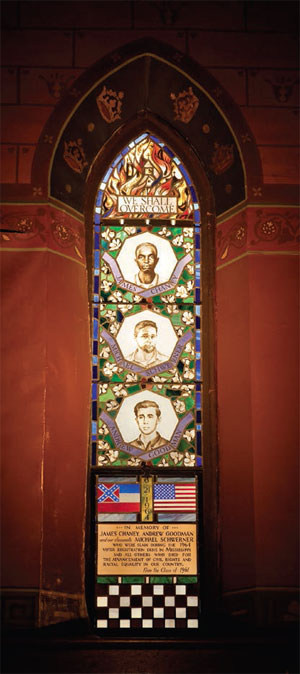
Sage Chapel memorial
In 1991, on the occasion of its 30th Reunion, the Class of 1961 dedicated a modest but striking memorial to a fallen classmate. In the hushed confines of Sage Chapel, a stained glass window depicts civil rights worker Mickey Schwerner ’61 and the two colleagues who were murdered with him, James Chaney and Andrew Goodman. Above them is an image of a burning church and the words “WE SHALL OVERCOME.”
Former campus activist Bill Schechter ’68 casts no aspersions on that memorial—but he wishes that Cornell had a more visible remembrance of the martyrs and their cause. “It’s a beautiful, personal tribute from the Class of 1961,” says Schechter. “But because of where it is, it can’t have a significant cultural impact on the campus. Very few students see it. Those who do are moved, but it’s a once-in-four-years experience.”
Last fall, Schechter launched an effort to build a prominent, outdoor civil rights memorial on campus. For the former high school history teacher, the issue strikes close to home: his older brother, Danny Schechter ’64, BS ILR ’65, went to Mississippi just months after the murders shook the nation.
Still in its early stages, the Schwerner-Chaney-Goodman Memorial Project has found support from members of the Class of ’61, the victims’ families, and nearly two dozen campus organizations, Schechter says. University officials have met with the planners, and are generally supportive of the effort—but before the project can proceed, significant fundraising is needed. “Everybody sees this as something positive to do,” Schechter says. “It not only celebrates the past but encourages us to consider issues like interracial unity, democracy, equal rights. It’s a unifying message.” With this summer marking the fiftieth anniversary of the murders—and Cornell celebrating its 150th birthday next year—he thinks the time is right. “The civil rights movement not only changed the country, it changed the campus,” he says. “A sesquicentennial is a time when an institution looks back and takes stock of its history. If this is ever going to happen, it would be now.”


